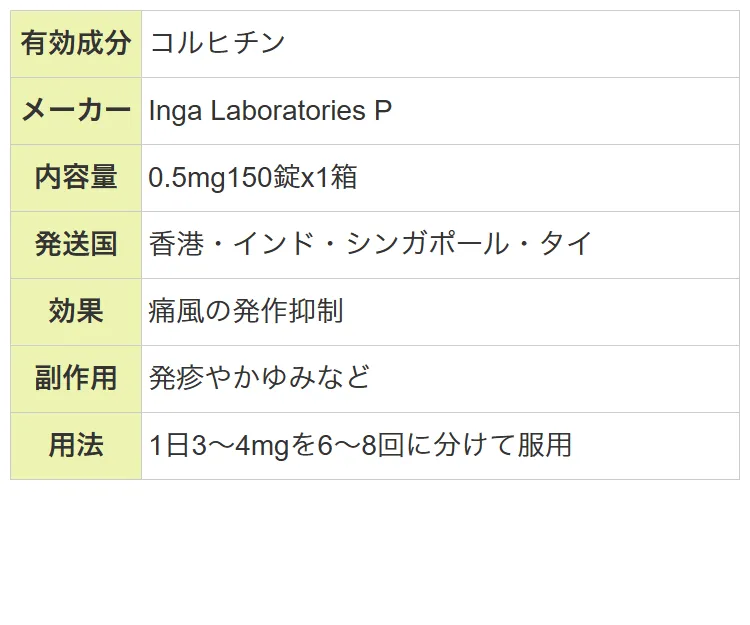痛みや腫れが抑えられます。安くてこんなにたくさんに入っていて最高です。

左記クレジットカード、銀行振込、コンビニ決済に対応





更新日:2025/6/25

| 個数 | 販売価格(1箱あたり) | 販売価格(箱) | ポイント | 購入 |
|---|---|---|---|---|
| 1箱 | 6,460円 | 6,460円 | 193pt |






①1万円以上で送料無料
1回の注文で10,000円以上だった場合、1,000円の送料が無料となります。
まとめ買いをすると1商品あたりのコストパフォーマンスが高くなるためおすすめです。
②プライバシー守る安心梱包
外箱に当サイト名や商品名が記載されることはないため、ご家族や配達員など第三者に内容を知られることは御座いません。

③100%メーカー正規品取り扱い
当サイトの商品は100%メーカー正規品となっており、第三者機関による鑑定も行っております。
商品の破損などがあった場合は再配送などにて対応させて頂きますので、ご連絡頂ければ幸いです。

④いつでも購入可能 処方箋不要
サイト上では24時間いつでもご注文を受けております。
また、お電話によるご注文も受け付けておりますのでネットが苦手な方はお気軽にどうぞ。

⑤商品到着100%
商品発送後はお荷物の追跡状況が分かる追跡番号をご案内させて頂きます。
郵便局には保管期限がありますのでご注意ください。
・自宅配達で不在だった場合の保管期限・・・16日間前後
・郵便局留めとした場合の保管期限・・・7~30日間

⑥コンビニ決済利用可能
ご近所のコンビニにていつでもお支払可能です。
セブンイレブンに限り店舗での機械操作を必要とせず、手続き完了後に表示されるバーコードや払込票番号をレジに提示することでお支払い頂けます。

ゴートニル 0.5mg150錠 x 1箱
6,460円
ポイント:193pt
10,000円以上購入で送料無料
在庫あり

痛みや腫れが抑えられます。安くてこんなにたくさんに入っていて最高です。
あんまり効果ないかも。飲んでも意味ないのかな。
ゴートニルを空腹時に服用することに関しては、添付文書などに指定はありません。そのため、空腹時の服用については問題ないと考えられます。ただし、適切な用法用量について不安な場合は、医師の指示を仰ぐようにしてください。
クラリスロマイシンはゴートニルの併用注意薬として指定されています。併用することでゴートニルの作用が増強され、副作用のリスクが増強するといった可能性が出てきます。そのため、どうしても併用しなければならないといったような場合には、併用しても問題がないか医師に確認するようにしてください。
ゴートニルは痛風の発作の緩和や予防に使用される治療薬です。発作の予防や緩和には役立ちますが発作を引き起こす痛風そのものに対してのアプローチはありません。そのため、ゴートニルによって痛風が改善するということはありません。
ゴートニルへの精子への影響に関する言及としては、コルヒチン錠を製造する高田製薬が発表しているインタビューフォームに「子供を持とうと計画している夫婦に対して、夫婦いずれかのコルヒチン錠の内服は、妊娠成立3ヵ月前から中止することが勧められる 」とあります。そのため、子供を持とうとしている夫婦の方は服用に注意が必要です。
ザイロリックとゴートニルの併用にかんする注意はありません。ただし、ザイロリックは痛風発作を悪化させるおそれがあります。そのため、痛風発作時などは症状が治まってから服用したり服用量を減らすといった必要があります。
治療薬の服用量については、用法用量を守ることが重要です。また、服用量の増減については症状や尿酸値などの状態を確認しながら医師の判断で行います。そのため、自身で適当に治療薬の増減を決定するのはリスクの高い行為なのでお避け下さい。
痛風の際に処方される治療薬はそれぞれの治療薬ごとに尿酸を抑える、発作を予防する、発作の痛みを和らげるといったように用途が違っています。そのため、自身の痛風の症状や状態に合わせて適切なものを服用する必要があります。
痛風の改善のために処方される治療薬の副作用として眠気などは報告されていません。そのため、眠気などがあらわれたと異様な場合には、痛風薬以外の原因が考えられます。
痛風治療薬を飲まずに尿酸を下げるといったことは可能ではありますが、治療薬を使用する場合と比べてその効果は大きくありません。また、悪化の恐れもあるため、痛風治療薬を使用することが推奨されています。
痛風の治療薬は尿酸値が正常になったとしても、関節に蓄積した尿酸血症がなくなるというわけではありません。そのため、すぐに服用を辞めると痛風発作が起きるおそれがあるため、正常値に戻った後もしばらくは継続して服用する必要があります。
| 1日の服用回数 | 6~8回 |
|---|---|
| 1回の服用量 | 0.4~0.7mg |
| 服用のタイミング | 指定なし |
| 服用間隔 | 指定なし |
| 1日の服用回数 | 1回 |
|---|---|
| 1回の服用量 | 0.5~1mg |
| 服用のタイミング | 指定なし |
| 服用間隔 | 指定なし |
| 1日の服用回数 | 1~2回 |
|---|---|
| 1回の服用量 | 0.25~0.5mg |
| 服用のタイミング | 指定なし |
| 服用間隔 | 指定なし |
| 商品名 | ザイロリック | ザイロリック・ジェネリック | ポトレート | ベネシッド | コルヒチンリア | トピロキソ |
|---|---|---|---|---|---|---|
| 商品画像 |  |  |  |  |  |  |
| 特徴1 | 痛風の直接原因となる尿酸を減少させる | 痛みの原因・尿酸を減らす抗痛風薬 | ・尿や体液をアルカリ化 | ・尿酸を尿と一緒に排泄 | ・白血球の活動を制限 | ・尿酸の過剰な生成を抑制 |
| 特徴2 | 製造元は実績あるイギリス発大手メーカー | 先発薬ザイロリックより成分配合量が多い | ・尿路結石の予防にも有効 | ・痛風や高尿酸血症が改善 | ・炎症反応を抑制 | ・尿路結石を合併している人にも有効 |
| 内容量 | 100mgx100錠 | 100mgx84錠 | 540mg100錠x1箱 | 500mg100錠x1箱 | 0.5mg30錠x1箱 | 20mg100錠x1箱 |
| 価格 | 5,360円 | 5,860円 | 3,160円 | 5,260円 | 4,260円 | 6,460円 |
本製品は海外製のため、期限表記が日本と異なる場合がございます。
パッケージ裏面や側面、シートなどに以下のような表記がされています。
| EXP | 使用期限 例:EXP 12/2025→2025年12月まで使用可 |
|---|---|
| MFG または MFD | 製造日 例:MFG 03/2023 |
| BEST BEFORE | 品質が最も安定している目安日 |


※国や製品により日付の並び(例:月/年、日/月/年)が異なる場合がありますのでご注意ください
EXP(Expiry Date) の表記がなく、MFG または MFDしか記載がないケースがあります。
この場合は MFG(MFD) から2~3年が使用期限の目安です。
※「LOT」や「BATCH」の表記は製造番号であり期限ではありません。

パッケージ例となります。
商品やご注文単位によってはシート単位でのお届けとなる場合が御座います。
外箱に当サイト名や商品名が記載されることはないため、ご家族や配達員など第三者に内容を知られることは御座いません。
あんまり効果ないかも。飲んでも意味ないのかな。
副作用が一切ないです。コレが無いと痛みに耐えれないので本当に助かってます。
痛みや腫れが抑えられます。安くてこんなにたくさんに入っていて最高です。
まだ飲み始めですが、副作用は今のところないので身体に合っていると思います。
これが無いと私はダメなくらいです(笑)めちゃくちゃ効果あります!
商品口コミの投稿は会員のみ行えるようになっております。
お手数ですが会員ログインの上でご投稿頂きますようお願いいたします。
口コミをご投稿頂いたお客様にはポイントをプレゼントさせて頂いております。
文章のみであれば100ポイント、文章+写真付きのものは300ポイントをプレゼントさせて頂きます。
規約や詳細などはこちらをご確認くださいませ。